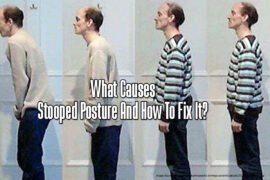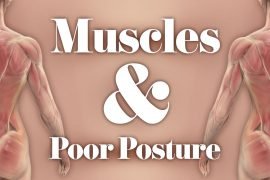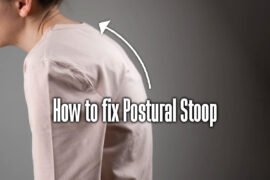Various factors can cause a Dowager’s hump, but the most common cause is poor posture. If you have a Dowager’s hump because of poor posture, this is an article you should read. We’ll go through what a Dowager’s hump is, why it happens, and what is the best way to fix it using corrective exercises in tandem.
What is a Dowager’s Hump?
Table of Contents
A Dowager’s Hump is a condition with an abnormal outward curvature of the upper spine, resulting in a noticeable rounding of the shoulders and upper back. It is most commonly seen in older women and may be caused by various factors, including osteoporosis, poor posture, and degenerative changes in the spine. The condition can lead to pain, discomfort, and difficulty with mobility, and in severe cases, can even affect breathing and other bodily functions. Treatment may include physical therapy, pain management, and exercises to improve posture & strengthen the back and neck muscles.
Causes of Dowager’s Hump
We’ve previously discussed how holding the body in an improper posture might cause a Dowagers hump. However, there are other reasons for this. A variety of other factors can also cause it. We can find the source of a Dowagers hump in four factors in medicine.
Age-related Degeneration
As we age, our human bones begin to lose strength and density, which can cause the spine to shrink and collapse. When this happens, the curvature of the spine can become more pronounced, leading to a Dowager’s hump. This process is known as age-related degeneration, and it is the most common cause of Dowager’s hump.
Osteoporosis
The condition known as osteoporosis can make bones weak and easily breakable. It is more frequently found in women who have undergone menopause. When the bones become weak, they are more likely to collapse or fracture, and this can cause a curvature of the spine, leading to a Dowager’s hump.
Poor posture
Poor posture may contribute to the development of Dowager’s hump. When we slouch or hunch over, we put unnecessary strain on our spine, which can cause the vertebrae to compress and collapse. Over time, this can cause the curvature of the spine to become more pronounced, leading to a Dowager’s hump.
Scoliosis
Scoliosis causes abnormal curvature of the spine, which can contribute to the development of Dowager’s hump. When the spine is curved, it may put pressure on the vertebrae, causing them to compress and collapse. This can cause the curvature of the spine to become more pronounced, leading to a Dowager’s hump.
Muscle Weakness
Weak muscles in the back and core can also contribute to the development of Dowager’s hump. When the muscles are weak, they are not able to support the spine properly, and this can cause the vertebrae to compress and collapse. This can cause the curvature of the spine to become more pronounced, leading to a Dowager’s hump.
Genetics
In some cases, Dowager’s hump can be caused by genetics. Some people can have a genetic predisposition to develop a curvature of the spine, and this can lead to the development of a Dowager’s hump. While genetics cannot be changed, there are steps that can be taken to manage the condition and prevent it from getting worse.
Medical Conditions
Certain medical conditions can also contribute to the development of Dowager’s hump. These include conditions that affect the bones, such as osteoporosis and Paget’s disease, as well as conditions that affect the nerves and muscles, like muscular dystrophy and spinal cord injuries.
Symptoms of Dowager’s Hump
A dowager’s hump manifests as a gradual rounding of the shoulders and upper back due to excessive curvature of the thoracic spine. This pitched-forward postural deformity creates a conspicuous protrusion and robs the figure of grace and poise.
The spine and brain work in concert as the central nervous system, coordinating the complex dialogue between mind and body. Disruptions to the spine can therefore reverberate system-wide, with symptoms manifesting throughout the body. The delicate spinal nerves branch out from the spinal cord, forming a network of 32 pathways that relay messages between the central nervous system and the rest of the body.
A severely misaligned spine with abnormal curvature pinches surrounding nerves, resulting in additional symptoms beyond an unsightly hump. Even a moderate curvature impairs nerve function and contributes to a gradual loss of mobility, flexibility, and independence. Without intervention, the dowager’s hump leads to a cycle of deterioration and discomfort. Some common symptoms associated with dowager’s hump include:
Visible Hump on the Upper Back
One of the most noticeable symptoms of dowager’s hump is the presence of a visible hump on the upper back. This hump is located just below the neck and can range in size from small to very large. The hump is made up of excess bone and soft tissue and is caused by the forward curvature of the thoracic spine.
Rounded Shoulders
Another symptom of a dowager’s hump is rounded shoulders. The excessive curvature of the spine can cause the shoulders to roll forward, leading to a hunched posture. This can result in muscle imbalances, with some muscles becoming tight and others becoming weak.
Back Pain
Many people with dowager’s hump experience back pain. This pain can be severe or mild and may be felt in the upper back, shoulders, and neck. The pain can be caused by the strain on the ligaments and muscles in the back due to altered spinal alignment.
Limited Mobility
The curvature of the spine can also limit mobility. People with a dowager’s hump may find it difficult to move their arms and shoulders, particularly when trying to reach up or behind themselves. This limited mobility can impact daily activities, such as dressing and grooming.
Fatigue
Fatigue is another symptom of dowager’s hump. The altered posture can cause the body to work harder to maintain balance and perform daily activities. This increased effort can lead to fatigue and exhaustion, particularly in older adults.
Breathing Difficulties
In severe cases, dowager’s hump can lead to breathing difficulties. The forward curvature of the spine can compress the lungs and chest cavity, making it difficult to take deep breaths. This can result in shortness of breath, particularly during physical activity.
Digestive Issues
The altered posture associated with a dowager’s hump can also impact digestive function. The compression of the chest cavity can affect the position of the organs in the abdomen, leading to digestive issues like bloating and constipation.
Balance Problems
The altered posture associated with the dowager’s hump can also impact balance. The hunched posture can make it more difficult to maintain balance while standing or walking, increasing the risk of falls and injuries.
Headaches
Some people with dowager’s hump may also experience headaches. These headaches may be caused by the strain on the muscles in the neck and shoulders due to altered posture.
Numbness and Tingling
Sometimes, dowager’s hump can also cause numbness and tingling in the arms and hands. This may be caused by nerve compression due to the altered spinal alignment.
How Do I Diagnose Dowager’s Hump?
To definitively diagnose Dowager’s hump, lateral spine X-rays taken while standing are most effective. These side-view images allow physicians to fully visualize changes in the natural curvature of the spine that characterize this condition. Images taken while lying may also reveal the hallmark spinal deformity for patients unable to stand during X-rays. A radiographic measurement offers precision in determining the kyphotic angle, though this method is not commonly employed due to its reliance on imaging technology. To qualify as Hyperkyphosis, the thoracic angle must measure greater than 40 degrees.
Alternative diagnostic methods that don’t rely on imaging include the Debrunner Kyphometer and flexicurve ruler. These simple yet precise tools offer a hands-on approach to analyzing spinal curvature and alignment. The Debrunner Kyphometer elegantly and precisely measures the curvature of the spine. Resembling a protractor, its simple yet ingenious design allows for an accurate assessment of the angle of spinal curvature. FlexiCurve Ruler is a plastic material that may be molded to measure a curve. Here are some steps you may take to diagnose Dowager’s hump:
Self-examination
The first step is to take a look at your spine and neck in the mirror. Stand up straight with your arms at the sides, and turn to the side to get a good view of your back. If you notice a noticeable curvature in your upper spine, or if you have a visible hump at the base of your neck, you may have Dowager’s hump.
Medical examination
If you suspect you have Dowager’s hump, it’s important to see a doctor for a thorough examination. Your doctor likely perform a physical exam to check your spine and evaluate your range of motion. They can order imaging tests such as X-rays or MRI to get a closer look at your spine and rule out any underlying conditions that may be causing your symptoms.
Bone density testing
Dowager’s hump can be caused by osteoporosis, a condition in which bones become weak and brittle. If your doctor suspects osteoporosis may be contributing to your hump, they may order a bone density test to measure the strength of your bones.
Medical history
Your doctor may ask you about your medical history, including any previous injuries and conditions that may have contributed to your hump. They may also ask about any medications you’re taking, as some drugs can contribute to bone loss and increase the risk of osteoporosis.
Best Exercises To Fix Dowager’s Hump
Certain movements can be helpful to get rid of the dowager’s hump caused by poor posture. It is crucial to perform exercises that strengthen your back muscles to enhance the appearance and alignment of your spine. You can perform five simple exercises daily to improve your posture and counteract the dowager’s hump. Check them out!
Scapular Retractions
The exercise called scapular retractions is designed to target the opening of your shoulders and chest. This technique assists in relaxing the shoulders and reducing roundness for improved posture. Please sit down with your feet positioned flat on the ground. Perform ten repetitions of squeezing your shoulder blades together and holding for five seconds each time. Make sure to avoid shrugging your shoulders and arching your lower back.
Wall Angels
Wall angels can improve spine alignment and strengthen the shoulder muscles and muscles that support the lower body. Please stand with your back against the wall & keep your arms at your sides with palms facing forward and the backs of your hands against the wall. Please ensure that your head, shoulders, butt, and low back touch the wall, and keep your feet approximately three inches away from the wall with a slight bend in your knees. Lift your arms above your head while engaging your core and pulling your belly button towards your spine, doing it slowly. Make sure to keep your head, shoulders, butt, and lower back touching the wall while lifting your arms. Return your arms to the starting position and do ten repetitions.
Cervical Extension Stretch
This stretch can assist in enhancing your spinal mobility, resulting in improved alignment. Please start by sitting down with your feet positioned flat on the floor. Pull your neck straight back as if you were making a double chin. Lift your chin up and maintain the position for five seconds. Then, go back to the initial position while looking straight ahead and do repetitions ten times.
Thoracic Extension
Performing thoracic extension exercises can be beneficial for enhancing the mobility of the chest and shoulders, upper back (thoracic spine) mobility, and overall spine alignment, which can lead to better posture. First, sit in a chair with your feet flat on the floor & your back supported by the chair’s back. Please place your hands behind your head to support your neck. Arch your upper back over the top of the chair while tightening your core muscles and looking upward. Hold this position for five seconds. Make sure to keep your lower back straight during the stretch. Perform ten repetitions.
Chin Tucks
By gently lifting the chin, chin tucks help align the cervical spine with the upper thoracic spine. This simple exercise enhances both posture and neck strength through proper spinal positioning and muscular engagement. Sit with your feet sturdily planted on the floor. Hold your head high and pull your chin straight back to feel a gentle stretch in the front of your neck. Pause for five seconds, then release. Repeat for ten repetitions. This simple exercise helps improve your posture and neck flexibility.
Things To Avoid While Suffering From Dowager’s Hump
To alleviate the symptoms and prevent further complications, there are several things you must avoid while suffering from dowager’s hump:
- Poor Posture: Avoid slouching or sitting in a hunched position, as it can worsen your condition.
- Heavy Lifting: Avoid lifting heavy objects as they can put pressure on your spine, which may exacerbate the curvature.
- Lack of Physical Activity: Avoid being inactive for prolonged periods. Regular physical activity, like walking, swimming, or low-impact exercises, can help to strengthen the muscles around your spine and improve your posture.
- Smoking: Avoid smoking as it can weaken the bones and increase the risk of osteoporosis, which can lead to further deterioration of the spine.
- High Heels: Avoid wearing high heels as they can affect your posture and put undue pressure on your spine.
- Poor Nutrition: Avoid a diet lacking vitamin D and calcium. These nutrients are important for preventing osteoporosis and maintaining strong bones.
- Stress: Avoid stress, which can cause muscle tension, leading to poor posture and increased pain.
FAQs
Q1. Can a Dowager’s Hump be fixed?
A: Yes, a Dowager’s Hump can be fixed with the right treatment approach. Physical therapy, exercises, and postural correction techniques can effectively reduce the curvature of the spine and improve overall posture.
Q2. What exercises can help fix a Dowager’s Hump?
A: Exercises that focus on strengthening the upper back muscles, improving posture, and increasing spinal flexibility can be helpful in reducing a Dowager’s Hump. Examples include chin tucks, shoulder blade squeezes, and thoracic spine extensions.
Q3. Can wearing a back brace help fix a Dowager’s Hump?
A: Wearing a back brace can provide temporary relief from the discomfort associated with a Dowager’s Hump, but it may not be effective in correcting the underlying problem. Consult with a medical professional before using any back brace.
Q4. Can surgery fix a Dowager’s Hump?
A: In some cases, surgery may be necessary to correct a Dowager’s Hump. However, surgery is mostly considered a last resort and is only recommended when other treatment options have failed.
Q5. How much time does it take to fix a Dowager’s Hump?
A: The amount of time it takes to fix a Dowager’s Hump can vary depending on the severity of the condition and the treatment approach used. It may take several months of consistent physical therapy and exercise to improve posture and spinal curvature significantly.
Q6. Can a Dowager’s Hump be prevented?
A: Yes, maintaining good posture, staying physically active, and consuming a healthy diet with adequate calcium and vitamin D can help prevent a Dowager’s Hump. It’s also important to seek prompt medical attention for any spinal injuries or conditions that could contribute to developing a Dowager’s Hump.
Conclusion
There are many effective methods to manage and even reverse this condition. By engaging in regular exercise, maintaining good posture, adjusting ergonomics, and seeking medical advice, individuals can work towards reducing the severity of their Dowager’s Hump and improving their quality of life. It is essential to remember that the success of these ways may vary depending on the severity of the condition, so it is essential to consult the doctor before beginning any new treatments or exercises.







